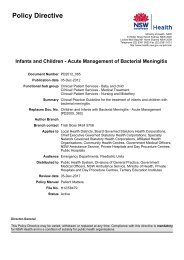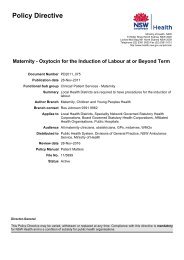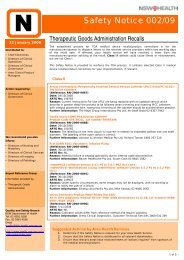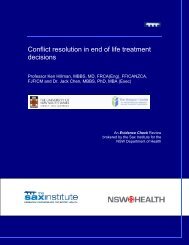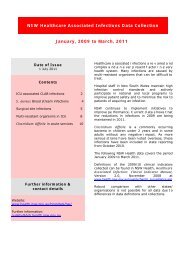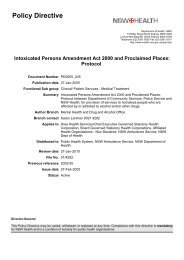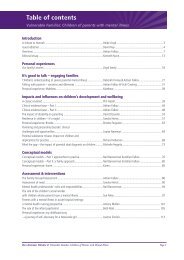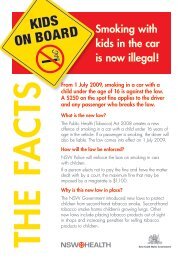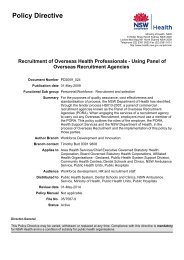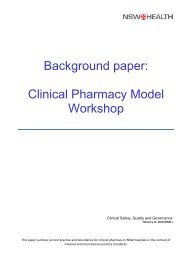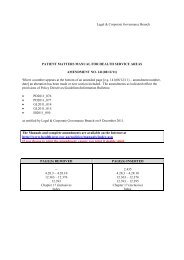NSW Methadone Clinic Accreditation Standards - NSW Health ...
NSW Methadone Clinic Accreditation Standards - NSW Health ...
NSW Methadone Clinic Accreditation Standards - NSW Health ...
You also want an ePaper? Increase the reach of your titles
YUMPU automatically turns print PDFs into web optimized ePapers that Google loves.
<strong>NSW</strong> <strong>Methadone</strong><br />
<strong>Clinic</strong> <strong>Accreditation</strong><br />
<strong>Standards</strong>
<strong>NSW</strong> HEALTH DEPARTMENT<br />
This work is copyright. It may be reproduced in whole or<br />
in part for study training purposes subject to the inclusion<br />
of an acknowledgement of the source and no commercial<br />
usage or sale.<br />
Copyright <strong>NSW</strong> <strong>Health</strong> Department 2000<br />
State <strong>Health</strong> Publication No: (DTS) 010018<br />
ISBN: 0 7347 3263 5<br />
For more information and further copies, please contact:<br />
Better <strong>Health</strong> Centre - Publications Warehouse<br />
Locked Mail Bag 5003 Gladesville 2111<br />
Tel. (02) 9816 0452<br />
Fax. (02) 9816 0492<br />
A full copy of this report can be downloaded from the<br />
<strong>NSW</strong> <strong>Health</strong>Web/Net site: www.health.nsw.gov.au<br />
November 2000<br />
Reprinted February 2001
Introduction<br />
In response to the recommendations of the <strong>NSW</strong><br />
Drug Summit held in May 1999 the Government<br />
committed <strong>NSW</strong> <strong>Health</strong> to take action to improve<br />
methadone and other pharmacotherapy programs.<br />
The <strong>NSW</strong> Government has also committed significant<br />
additional resources to expand the methadone<br />
program across the State. Given the extent of harms<br />
associated with opioid dependence it is imperative that<br />
methadone maintenance treatment is delivered<br />
effectively, efficiently and to a high degree of quality.<br />
<strong>Methadone</strong> is the main option for the treatment<br />
of opioid dependence across Australia. <strong>Methadone</strong><br />
treatment is the best researched of all treatments and<br />
has been shown through research to be effective in<br />
reducing heroin use, deaths from overdose, the spread<br />
of blood borne viruses such as HIV, hepatitis C,<br />
and crime.<br />
<strong>NSW</strong> <strong>Health</strong><br />
This set of standards forms the basis of an<br />
accreditation program for all licensed methadone<br />
clinics in New South Wales. New, additional<br />
conditions have been imposed on all existing licences<br />
for methadone clinics that require clinics to join an<br />
approved quality assurance organisation and to achieve<br />
accreditation within a specified time-frame.<br />
These standards will be used by approved quality<br />
assurance organisations to develop survey instruments<br />
and supporting documentation as part of the program<br />
to accredit methadone clinics across New South Wales.<br />
These standards complement the quality of health care<br />
approach outlined in the Department’s Framework for<br />
Managing the Quality of <strong>Health</strong> Services in <strong>NSW</strong>.<br />
Andrew Wilson<br />
Deputy Director-General,<br />
Public <strong>Health</strong> and Chief <strong>Health</strong> Officer<br />
<strong>NSW</strong> <strong>Methadone</strong> <strong>Clinic</strong> <strong>Accreditation</strong> <strong>Standards</strong> i
Contents<br />
Introduction . . . . . . . . . . . . . . . . . . . . .iii<br />
Continuum of care . . . . . . . . . . . . . . . . .1<br />
Standard 1 Access . . . . . . . . . . . . . . . . . . . . .1<br />
Standard 2 Entry . . . . . . . . . . . . . . . . . . . . .1<br />
Standard 3 Assessment . . . . . . . . . . . . . . . . . .2<br />
Standard 4 Care Planning . . . . . . . . . . . . . . .2<br />
Standard 5 Implementation of Care . . . . . . . .3<br />
Prescribing<br />
<strong>Methadone</strong> Administration<br />
Takeaway doses<br />
Standard 6 Care Review . . . . . . . . . . . . . . . .5<br />
Standard 7 Cessation of Treatment<br />
Episode and Aftercare . . . . . . . . . .6<br />
Leadership and Management . . . . . . . . . .7<br />
Standard 1 Governance . . . . . . . . . . . . . . . .7<br />
Managers . . . . . . . . . . . . . . . . . . .7<br />
Strategic and Operational Plans . . .7<br />
<strong>Clinic</strong> Structure . . . . . . . . . . . . . .8<br />
By laws, Policies and Procedures . . .8<br />
Rights and Responsibilities . . . . . .8<br />
Ethics . . . . . . . . . . . . . . . . . . . . .8<br />
Financial Management . . . . . . . . .8<br />
External Providers . . . . . . . . . . . . .8<br />
Standard 2 Community Information<br />
Education . . . . . . . . . . . . . . . . . .9<br />
Human Resources Management . . . . . . . .10<br />
Standard 1 Human Resources Planning . . . . . .10<br />
Standard 2 Recruitment, Selection<br />
and Appointment . . . . . . . . . . . . .10<br />
Standard 3 Staff Responsibilities . . . . . . . . . . .11<br />
Standard 4 Staff Training and Development . . .11<br />
Standard 5 Supervision of <strong>Clinic</strong>al Staff . . . . .12<br />
Information Management . . . . . . . . . . . . .13<br />
Standard 1 Data Collection . . . . . . . . . . . . . .13<br />
Data Collection Process . . . . . . . . .13<br />
Reporting Systems . . . . . . . . . . . .13<br />
Standard 2 Record Management . . . . . . . . . .13<br />
Standard 3 Medico-legal issues . . . . . . . . . . . .14<br />
Safe Practice and Environment . . . . . . . . .15<br />
Safe Practice and Environment . . . .15<br />
Staff <strong>Health</strong> Issues . . . . . . . . . . . . .15<br />
Security . . . . . . . . . . . . . . . . . . . .15<br />
Fire Safety . . . . . . . . . . . . . . . . . .15<br />
Emergency Planning . . . . . . . . . . .15<br />
Planning and Purchasing<br />
of Equipment and Supplies . . . . . .16<br />
Provision of Equipment<br />
and Supplies . . . . . . . . . . . . . . . . .16<br />
Building requirements, functional<br />
design and layout . . . . . . . . . . . . .17<br />
Utilities (Water, Gas, Electricity<br />
and Ventilation) . . . . . . . . . . . . . . .18<br />
Maintenance . . . . . . . . . . . . . . . .18<br />
Waste Management . . . . . . . . . . . .18<br />
Improving Performance . . . . . . . . . . . . . .19<br />
Performance Improvement<br />
System . . . . . . . . . . . . . . . . . . . . .19<br />
Performance Improvement<br />
Methodology . . . . . . . . . . . . . . . .19<br />
Acknowledgments . . . . . . . . . . . . . . . . . .20<br />
Notes . . . . . . . . . . . . . . . . . . . . . . . . . .21<br />
ii <strong>NSW</strong> <strong>Methadone</strong> <strong>Clinic</strong> <strong>Accreditation</strong> <strong>Standards</strong> <strong>NSW</strong> <strong>Health</strong>
Continuum of Care<br />
Standard 1 – Access<br />
The <strong>Methadone</strong> Maintenance <strong>Clinic</strong> is<br />
accessible to the community it serves.<br />
Accessibility means maximising the use of the<br />
methadone maintenance clinic by the target<br />
community. Particular strategies may be needed to<br />
reach and provide appropriate services for marginalised<br />
groups.These may include women with children,<br />
young people, Aboriginal and Torres Strait Islanders,<br />
people from culturally and linguistically diverse<br />
backgrounds as well as people with disabilities.<br />
MMC 1.1.1 The community that the clinic serves is<br />
defined and the needs of the<br />
community are addressed in the<br />
planning and provision of services.<br />
MMC 1.1.2 The service provides disabled access.<br />
MMC 1.1.3 Hours of operation of the clinic are<br />
appropriate to the needs of the service<br />
users and are well publicised.<br />
MMC 1.1.4 The dosing location is as convenient as<br />
possible to the client’s home or work.<br />
MMC 1.1.5 When the clinic is closed, signs and a<br />
telephone answering machine give the<br />
opening hours of the clinic and direct<br />
clients to appropriate local emergency<br />
services.<br />
MMC 1.1.6 The service has reasonable access to<br />
public transport and is located away<br />
from residential development.<br />
MMC 1.1.7 There is short-term parking available.<br />
MMC 1.1.8 The service users are satisfied with the<br />
ease of access of the clinic.<br />
Recommended Reading<br />
Bridging the gap: working cross culturally with alcohol and<br />
other drug issues. Rozelle: CEIDA, 1995.<br />
<strong>NSW</strong> <strong>Health</strong><br />
Standard 2 - Entry<br />
The process of entry to the <strong>Clinic</strong> meets<br />
client needs and is facilitated through<br />
effective systems and a suitable<br />
environment.<br />
MMC 1.2.1 The clinic has a system for identifying<br />
and registering clients.<br />
MMC 1.2.2 All staff use written procedures for the<br />
registration and referral of clients.<br />
MMC 1.2.3 Informed consent for methadone<br />
maintenance treatment is obtained by<br />
the prescribing doctor.<br />
MMC 1.2.4 All clients are informed of their rights<br />
and responsibilities in a timely and<br />
effective manner.<br />
MMC 1.2.5 Fees and other charges are made clear<br />
to the client, both verbally and in<br />
writing, prior to commencement of<br />
the program.<br />
MMC 1.2.6 The service has a protocol in place for<br />
transfer of clients into or out of the<br />
service.The protocol is consistent with<br />
legislation and the <strong>NSW</strong> <strong>Methadone</strong><br />
Maintenance Treatment <strong>Clinic</strong>al<br />
Practice Guidelines.<br />
MMC 1.2.7 Throughout the care process care<br />
providers document all aspects of care<br />
necessary to assist communication.<br />
MMC 1.2.8 Clients with health issues such as<br />
pregnancy, HIV or other serious<br />
illnesses are given immediate care and<br />
appropriate referrals organised.<br />
<strong>NSW</strong> <strong>Methadone</strong> <strong>Clinic</strong> <strong>Accreditation</strong> <strong>Standards</strong> 1
Standard 3 – Assessment<br />
Client care planning is supported by<br />
comprehensive assessment.<br />
A detailed and appropriately planned and conducted<br />
assessment process enables the clinic to offer the<br />
client information about methadone maintenance<br />
services.This might include when and where the<br />
service is available, and procedures and policies<br />
covering confidentiality, behavioural boundaries,<br />
complaints and client rights.<br />
MMC 1.3.1 A comprehensive assessment of the<br />
client is performed by qualified staff.<br />
MMC 1.3.2 Assessments cover key areas including:<br />
a Socio-demographic data (name,<br />
address, gender)<br />
b pattern of drug use<br />
c health, social, economic and legal<br />
consequences of drug use<br />
d the service user’s perception of<br />
their need<br />
e whether other agencies need to be,<br />
or are, involved<br />
f identification of possible<br />
aftercare needs<br />
g target outcomes for the care process<br />
MMC 1.3.3 Assessment is coordinated to reduce<br />
unnecessary repetition.<br />
MMC 1.3.4 Assessment is completed, documented<br />
and communicated to relevant persons<br />
MMC 1.3.5 Where a client is between 16 and 18<br />
years of age, the client is reviewed by<br />
two independent medical officers before<br />
the application is sent to the<br />
Pharmaceutical Services Branch, <strong>NSW</strong><br />
<strong>Health</strong> Department for processing and<br />
proof of age is provided.<br />
Standard 4 – Care Planning<br />
A coordinated plan of care, incorporating<br />
goals, is developed through collaboration<br />
between clients and the health care team<br />
to achieve desired outcomes.<br />
Care planning ensures that service users receive<br />
appropriate, supportive and relevant services.<br />
MMC 1.4.1 Each client has a care plan that provides<br />
for their individual clinical, social and<br />
emotional needs.<br />
a The client is actively involved in<br />
formulating and reviewing the care<br />
plan.<br />
b Treatment and / or referral for other<br />
Drug and Alcohol problems or other<br />
health issues, including mental health<br />
issues, is offered to clients as required<br />
c Counselling/social services are<br />
available or referral to suitable<br />
persons or services are offered<br />
d The plan, when relevant, is linked<br />
with other care plans developed for<br />
the client, such as those from<br />
probation and parole or social services.<br />
MMC 1.4.2 The length of treatment is determined<br />
by the client’s needs.<br />
MMC 1.4.3 Updated lists of relevant resources and<br />
services are maintained and available for<br />
information and referral for staff and<br />
clients.<br />
MMC 1.4.4 The care plan is documented in the<br />
client record and includes:<br />
a whether methadone maintenance<br />
treatment will take place and if so,<br />
the justification, starting dose, early<br />
monitoring arrangements, initial<br />
harm reduction actions and case<br />
management arrangements<br />
b the alternative management<br />
recommendation if methadone<br />
maintenance treatment is not used<br />
2 <strong>NSW</strong> <strong>Methadone</strong> <strong>Clinic</strong> <strong>Accreditation</strong> <strong>Standards</strong> <strong>NSW</strong> <strong>Health</strong>
Standard 5 - Implementation<br />
of Care<br />
Care delivery is coordinated and provided<br />
according to the needs of the client, and<br />
the plan of care.<br />
MMC 1.5.1 Care is consistent with the <strong>NSW</strong><br />
<strong>Methadone</strong> Maintenance Treatment<br />
<strong>Clinic</strong>al Practice Guidelines.<br />
MMC 1.5.2 Care is delivered according to<br />
professional standards and statutory<br />
requirements.<br />
MMC 1.5.3 Care is delivered in partnership with<br />
the client.<br />
MMC 1.5.4 Clients acknowledge their rights and<br />
responsibilities in the implementation<br />
of care.<br />
MMC 1.5.5 Providers acknowledge their rights and<br />
responsibilities in the implementation<br />
of care.<br />
MMC 1.5.6 Rights and needs of clients are<br />
considered and respected by all staff. A<br />
charter of client rights or treatment<br />
agreement is displayed prominently and<br />
used in literature within the clinic.<br />
MMC 1.5.7 Care is co-ordinated to ensure<br />
continuity of care and follow-up to<br />
avoid duplication of the provision of<br />
service<br />
MMC 1.5.8 The plan of care and goals are revised in<br />
response to client progress and the<br />
client is actively involved in this process<br />
MMC 1.5.9 Client education is given by appropriate<br />
professionals<br />
MMC 1.5.10 Medico legal issues in relation to care<br />
are recognised, addressed, monitored and<br />
statutory requirements are met.<br />
MMC 1.5.11 Delivery of care is comprehensively and<br />
accurately recorded in the client record.<br />
MMC 1.5.12 Where a client is periodically detained,<br />
communication between the clinic and<br />
correctional facility is maintained in<br />
regard to dose and attendance.<br />
<strong>NSW</strong> <strong>Health</strong><br />
MMC 1.5.13 Care is delivered in a safe and<br />
comfortable environment.<br />
Prescribing<br />
MMC 1.5.14 A full medical assessment is undertaken<br />
on admission including physical<br />
examination and history of dependence<br />
with corroborative evidence of<br />
addiction.<br />
MMC 1.5.15 Careful observation of the client is<br />
undertaken in the critical first few<br />
weeks while the client is stabilising on<br />
methadone and then reviewed regularly<br />
thereafter. Clients are seen daily by an<br />
experienced clinician for at least the<br />
first four days.<br />
<strong>Methadone</strong> Administration<br />
MMC 1.5.16 <strong>Methadone</strong> is measured from<br />
equipment that is accurate and well<br />
maintained.<br />
MMC 1.5.17 <strong>Methadone</strong> administration and storage<br />
are recorded in the appropriate drug<br />
registers.<br />
MMC 1.5.18 Water or other fluids are supplied in an<br />
appropriate manner such as from main<br />
water supply or clean, well maintained<br />
equipment.<br />
MMC 1.5.19 Staff are aware of, and comply with, the<br />
<strong>NSW</strong> <strong>Methadone</strong> Maintenance <strong>Clinic</strong>al<br />
Treatment Practice Guidelines on<br />
specific clinical situations including:<br />
a missed doses<br />
b vomited doses<br />
c spilt doses<br />
d concurrent drug use<br />
e intoxication<br />
f accidental overdose at the<br />
administration point<br />
g selective detoxification<br />
h dosing in police cells, gaol or<br />
periodic detention<br />
i multiple administration points<br />
j administering methadone to patients<br />
at home<br />
k transfers – local, national and<br />
international<br />
l community pharmacies<br />
<strong>NSW</strong> <strong>Methadone</strong> <strong>Clinic</strong> <strong>Accreditation</strong> <strong>Standards</strong> 3
MMC 1.5.20 There is evidence that S8 drugs are used<br />
in accordance with statutory regulations<br />
governing documentation,<br />
administration, handling and storage;<br />
disposal of empty bottles and out of<br />
date drugs;<br />
MMC 1.5.21 Accidental breakages, spillages of<br />
methadone bottles are reported to the<br />
Chief Pharmacist, Pharmaceutical<br />
Services Branch, <strong>NSW</strong> <strong>Health</strong><br />
Department or a police officer.<br />
MMC 1.5.22 Contaminated methadone, returned<br />
takeaways or suspect liquids are<br />
destroyed by an Inspector from<br />
Pharmaceutical Services Branch, <strong>NSW</strong><br />
<strong>Health</strong> Department or a police officer.<br />
MMC 1.5.23 Where a fee is payable for dispensing,<br />
there is a system to assure financial<br />
accountability for staff and clients.<br />
MMC 1.5.24 There are arrangements in place to<br />
minimise the exposure of children<br />
accompanying clients for dosing.<br />
MMC 1.5.25 There is a policy that addresses nonpayment<br />
of dispensing fees.<br />
Takeaway Doses<br />
MMC 1.5.26 Takeaway doses may be provided after<br />
three months stable participation in the<br />
program and are provided only after<br />
careful assessment of the client’s stability<br />
and reliability, and never if there is<br />
concern that they will be misused.<br />
MMC 1.5.27 Takeaway doses are authorised by the<br />
prescribing doctor but are discussed<br />
with the clinician(s) or pharmacist with<br />
whom the client has regular contact.<br />
MMC 1.5.28 Assessment of suitability for takeaway<br />
methadone is clearly recorded in the<br />
clinical notes and includes:<br />
a details of indicators of stability<br />
b documentation of the absence of<br />
contraindications<br />
c details of any other psychoactive<br />
drugs being used.<br />
MMC 1.5.29 A review of takeaway dosing<br />
arrangements is prompted by indications<br />
of instability or unreliability in a client<br />
receiving takeaway doses.<br />
MMC 1.5.30 Takeaway doses are provided in new,<br />
non-breakable containers with child<br />
resistant lids and labels conforming to<br />
<strong>NSW</strong> <strong>Methadone</strong> Maintenance<br />
Treatment <strong>Clinic</strong>al Practice Guidelines.<br />
MMC 1.5.31 Takeaway doses are given in compliance<br />
with the <strong>NSW</strong> <strong>Methadone</strong> Maintenance<br />
Treatment <strong>Clinic</strong>al Practice Guidelines and<br />
are signed and dated as they are given.<br />
There is an account of takeaways not given.<br />
MMC 1.5.32 Takeaway doses are stored in a safe that<br />
complies with the Poisons Act 1966.<br />
MMC 1.5.33 Takeaway doses are made up by an<br />
appropriately qualified pharmacist.<br />
MMC 1.5.34 A record of takeaway doses is available<br />
and is easily retrievable.<br />
Recommended Reading<br />
<strong>NSW</strong> <strong>Methadone</strong> Maintenance Treatment: <strong>Clinic</strong>al Practice<br />
Guidelines Sydney: <strong>NSW</strong> <strong>Health</strong>, 1999.<br />
Kids Copy. Sydney: CEIDA, 1994<br />
4 <strong>NSW</strong> <strong>Methadone</strong> <strong>Clinic</strong> <strong>Accreditation</strong> <strong>Standards</strong> <strong>NSW</strong> <strong>Health</strong>
Standard 6 - Care Review<br />
Care delivery is evaluated by the clinical<br />
team to ensure that care continuously<br />
meets client needs and assists in the<br />
improvement of care provision<br />
Care review is an integral part of the care process. It<br />
establishes changes that have occurred since the initial<br />
assessment.The care plan and its implementation is<br />
reviewed regularly with the service user to:<br />
● ensure relevance and effectiveness of the care<br />
package<br />
● identify any unmet needs<br />
● ensure service user satisfaction<br />
MMC 1.6.1 During the first week of methadone<br />
maintenance treatment care is reviewed<br />
by an experienced clinician who:<br />
<strong>NSW</strong> <strong>Health</strong><br />
a collaborates with the client to<br />
identify current problems, and<br />
provide treatment and support where<br />
possible;<br />
b explains to the client the expected<br />
rate of methadone dose increase, the<br />
reasons why it is gradual and the risk<br />
of overdose if the methadone dose is<br />
increased too rapidly;<br />
c assesses the client for evidence of<br />
opioid and other drug intoxication;<br />
d provides education to the client<br />
about overdose risk, particularly the<br />
risk of combining other drugs with<br />
methadone and strategies to avoid<br />
and manage overdose;<br />
e assess the client for opioid or other<br />
drug withdrawal states;<br />
f continues the initial assessment;<br />
g provides information to the client<br />
about risks of needle-borne<br />
infections and other health risks;<br />
h provides more information about the<br />
operation and requirements of the<br />
methadone program.<br />
MMC 1.6.2 After the first four weeks of methadone,<br />
the initial treatment plan is reviewed in<br />
collaboration with the client and a<br />
treatment plan that is documented in<br />
the client record specifies:<br />
a plans for the client’s methadone dose<br />
b strategies to deal with drug use<br />
problems<br />
c strategies to deal with risk behaviours<br />
d strategies to deal with identified<br />
major medical, psychiatric and<br />
psychosocial problem areas<br />
MMC 1.6.3 The client’s treatment plan is reviewed<br />
at least every six months and revisions<br />
to the treatment plan are documented<br />
in the client record<br />
MMC 1.6.4 Treatment outcomes are recorded as<br />
part of the clinic’s outcome monitoring<br />
system.These include:<br />
a retention in treatment<br />
b prescriber / client satisfaction with<br />
dose level<br />
c heroin use<br />
d severity of heroin dependence<br />
e crime<br />
f non-opioid drug use<br />
g psychological functioning<br />
h social functioning<br />
i blood borne virus risk<br />
j respondents own assessment of<br />
treatment<br />
k reason for cessation of treatment<br />
<strong>NSW</strong> <strong>Methadone</strong> <strong>Clinic</strong> <strong>Accreditation</strong> <strong>Standards</strong> 5
Standard 7 – Cessation of<br />
Treatment Episode and After Care<br />
Clients are prepared for, and are confident<br />
about, their continuing management.<br />
Aftercare is integrated between the<br />
clinical team and community services to<br />
ensure the needs of the client are met.<br />
Careful monitoring and recording of both planned<br />
and unplanned cessation of treatment is essential to<br />
ensure that the needs of the client are being met.<br />
Aftercare services are often crucial in maximising the<br />
long term effectiveness of the care plan.<br />
MMC 1.7.1 Reason for cessation of treatment<br />
episode is appropriately documented in<br />
the client record and outcome<br />
monitoring system.<br />
MMC 1.7.2 Clients are informed of discharge plans<br />
in a timely manner.<br />
MMC 1.7.3 Clients have the right to terminate their<br />
program at any time, organise a<br />
voluntary reduction or transfer to an<br />
alternate treatment provider.<br />
MMC 1.7.4 When clients have broken the terms of<br />
the treatment agreement and are either<br />
exited immediately or transferred<br />
elsewhere, the process is explained to<br />
the client and clearly documented in<br />
the client record.<br />
MMC 1.7.5 Clients are not penalised for relapse or<br />
denied readmission unless there have<br />
been significant behavioural problems or<br />
multiple admissions to one facility and a<br />
repeat treatment episode is not in the<br />
best interest of the client or the program<br />
MMC 1.7.6 Where applicable, communication<br />
between the prison system and the<br />
clinic is maintained and the transition<br />
from the community to prison and<br />
prison to the community progresses<br />
smoothly and efficiently.<br />
MMC 1.7.7 Referrals and communication between<br />
the clinic and community services are<br />
timely, in writing and are documented<br />
in the client record.<br />
MMC 1.7.8 The clinic arranges access to a variety of<br />
services and clients are aware of these<br />
services.<br />
Recommended Reading<br />
Supply of <strong>Methadone</strong> Syrup under the <strong>NSW</strong> <strong>Methadone</strong><br />
Program. Notes for Community pharmacists. Sydney:<br />
<strong>NSW</strong> <strong>Health</strong>, 1999.<br />
<strong>NSW</strong> <strong>Methadone</strong> Maintenance Treatment: <strong>Clinic</strong>al Practice<br />
Guidelines. Sydney: <strong>NSW</strong> <strong>Health</strong>, 1999.<br />
6 <strong>NSW</strong> <strong>Methadone</strong> <strong>Clinic</strong> <strong>Accreditation</strong> <strong>Standards</strong> <strong>NSW</strong> <strong>Health</strong>
Leadership and Management<br />
Standard 1<br />
The organisation is effectively and<br />
efficiently governed and managed, in<br />
accordance with its values and goals, to<br />
ensure quality of care.<br />
Strategic management and development are essential<br />
to effective service operation and delivery, and to the<br />
development of good practice.<br />
Private sector methadone clinics<br />
Ultimate management responsibility within the private<br />
sector usually rest with the director(s) of the company.<br />
The director(s) has ultimate authority for decisions<br />
about major policy issues, finance, staffing, and service<br />
management and delivery.The director(s) of the<br />
company will also assume overall responsibility for<br />
evaluating performance against agreed targets and will<br />
need to have a close and effective working relationship<br />
with the senior manager of the clinic.<br />
Public sector methadone clinics<br />
<strong>Clinic</strong>s within the <strong>NSW</strong> public health system are part<br />
of a much larger care system. Management<br />
responsibility for the drug and alcohol service usually<br />
rests with the director or coordinator of the area drug<br />
& alcohol service. The director/coordinator has<br />
authority for decisions about major policy issues,<br />
finance, staffing, and service management and delivery.<br />
The director/coordinator of the drug and alcohol<br />
service will also assume responsibility for evaluating<br />
performance against agreed targets and will need to<br />
have a close and effective working relationship with<br />
the manager of the clinic.<br />
Managers<br />
MMC 2.1.1 The director/coordinator delegates the<br />
necessary authority to the manager of<br />
the clinic and ensures their<br />
responsibilities are defined to enable the<br />
service to operate effectively.<br />
MMC 2.1.2 The director/coordinator authorises an<br />
individual to act for the clinic manager<br />
when required.<br />
<strong>NSW</strong> <strong>Health</strong><br />
MMC 2.1.3 The clinic manager provides leadership<br />
and acts in accordance with corporate<br />
policies, delegated authority and<br />
instructions of the director/coordinator<br />
and is responsible for the management<br />
of the organisation and its specific<br />
services.<br />
MMC 2.1.4 The performance of the clinic manager<br />
is reviewed regularly.<br />
Strategic and Operational Plans<br />
MMC 1.2.5 The clinic’s values and goals direct its<br />
actions and behaviour and are reflected<br />
in its culture.<br />
MMC 2.1.6 The clinic’s role is responsive to the<br />
needs and expectations of the clients<br />
and community it serves.<br />
MMC 2.1.7 The clinic is planned, operated and<br />
evaluated in consultation and<br />
collaboration with all relevant<br />
stakeholders.<br />
MMC 2.1.8 <strong>NSW</strong> Department of <strong>Health</strong> guidelines<br />
for establishing methadone clinics are<br />
followed.<br />
MMC 2.1.9 The clinic’s planning involves<br />
consultation with management, staff, the<br />
community, clients and other relevant<br />
health service providers and authorities.<br />
MMC 2.1.10 Operational plans of the clinic are<br />
consistent with the organisation’s<br />
strategic plan.<br />
MMC 2.1.11 The clinic’s operational plans are<br />
implemented and revised as necessary.<br />
Achievement of the plans is monitored<br />
and action taken to address any<br />
improvements required.<br />
MMC 2.1.12 Where the clinic is part of an Area<br />
<strong>Health</strong> Service or multi-hospital system,<br />
the clinic participates in discussions and<br />
decisions on its current and future<br />
operations.<br />
<strong>NSW</strong> <strong>Methadone</strong> <strong>Clinic</strong> <strong>Accreditation</strong> <strong>Standards</strong> 7
MMC 2.1.13 The clinic’s services are integrated with<br />
other agencies providing drug, alcohol<br />
and other health services.<br />
MMC 2.1.14 The clinic facilitates the establishment<br />
of a consumer group to represent the<br />
needs and expectations of its clients.The<br />
group play a consultative role in policy<br />
and procedure formulation.<br />
<strong>Clinic</strong> Structure<br />
MMC 2.1.15 Service delivery is facilitated by the<br />
structure of the clinic.<br />
MMC 2.1.16 Established lines of responsibility,<br />
authority and communication support<br />
leadership, teamwork and integration of<br />
services both within the clinic and with<br />
other service providers.<br />
MMC 2.1.17 Management is responsible for<br />
establishing clear lines of<br />
communication, responsibility and<br />
accountability for all staff.<br />
MMC 2.1.18 The clinic structure is reviewed annually<br />
or whenever there is a significant<br />
change, such as alteration of the role of<br />
the clinic or its services.<br />
By-laws, Policies and Procedures<br />
MMC 2.1.19 The clinic’s policies and procedures<br />
support the delivery of care and are<br />
consistent with the clinic’s goals,<br />
accepted standards, the <strong>NSW</strong><br />
<strong>Methadone</strong> Maintenance Treatment<br />
<strong>Clinic</strong>al Practice Guidelines, statutory<br />
requirements and community<br />
responsibilities.<br />
MMC 2.1.20 Compliance with the clinic’s policies<br />
and procedures occurs within the clinic.<br />
The policies and procedures are<br />
reviewed and revised as necessary and, at<br />
least, every 3 years.<br />
MMC 2.1.21 A policy and procedures manual is<br />
available to direct staff in respect of the<br />
operation of the clinic.<br />
MMC 2.1.22 Protocols exist for the safe prescribing<br />
and provision of registered opioid<br />
maintenance drugs and are<br />
implemented by appropriate staff.<br />
Rights and Responsibilities<br />
MMC 2.1.23 Rights and responsibilities of clients are<br />
respected and are addressed through<br />
policies and procedures that are in<br />
accordance with the values of the clinic,<br />
professional codes of ethics and the<br />
<strong>NSW</strong> <strong>Methadone</strong> Maintenance<br />
Treatment <strong>Clinic</strong>al Practice Guidelines.<br />
MMC 2.1.24 The clinic explicitly informs the client<br />
of their rights and responsibilities.<br />
Ethics<br />
MMC 2.1.25 All activities are consistent with<br />
recognised ethical requirements of the<br />
professionals delivering care in the clinic.<br />
Financial Management<br />
MMC 2.1.26 Financial management is used in the<br />
achievement of the organisation’s goals<br />
and strategic plans.<br />
MMC 2.1.27 The director/coordinator oversees the<br />
finances of the organisation.<br />
Management processes are established to<br />
ensure the financial resources of the<br />
organisation are appropriately managed,<br />
reported and consistent with accepted<br />
standards and statutory requirements.<br />
External Providers<br />
MMC 2.1.28 When selecting external providers that<br />
are part of the clinical team, the<br />
compatibility of their clinic policy with<br />
the policies of the clinic is to be<br />
considered.<br />
8 <strong>NSW</strong> <strong>Methadone</strong> <strong>Clinic</strong> <strong>Accreditation</strong> <strong>Standards</strong> <strong>NSW</strong> <strong>Health</strong>
Standard 2 - Community<br />
Information/Education<br />
Community concerns about methadone<br />
are addressed by pro-active community<br />
liaison/education<br />
MMC 2.2.1 There is evidence of initiatives to<br />
develop working relationship with the<br />
public and private sector, including<br />
general practitioners, other health<br />
professionals, Corrective Services, the<br />
local police, the ambulance service and<br />
consumer groups.<br />
MMC 2.2.2 There is appropriate and timely<br />
communication with stakeholders in the<br />
local community (eg. local council,<br />
Chamber of Commerce, Local Safety<br />
Committee, police service and<br />
community welfare) about the service.<br />
MMC 2.2.3 Care offered by the clinic is in concert<br />
with, and augmented by, appropriate<br />
community education to build a<br />
constructive relationship between the<br />
clinic, clients and the community.<br />
MMC 2.2.4 There is a community liaison and<br />
education policy in place which serves<br />
to allay community concerns about<br />
methadone maintenance programs in<br />
the community, and addresses related<br />
stigma and misconceptions.<br />
MMC 2.2.5 The priorities of the local community<br />
are addressed in the clinic’s community<br />
liaison and education policy.<br />
<strong>NSW</strong> <strong>Health</strong><br />
<strong>NSW</strong> <strong>Methadone</strong> <strong>Clinic</strong> <strong>Accreditation</strong> <strong>Standards</strong> 9
Human Resources Management<br />
Standard 1 – Human Resources<br />
Planning<br />
Human resources planning ensures the<br />
organisation is staffed to achieve its goals<br />
and values.<br />
Planning is required to ensure that staff have the skills,<br />
qualifications and experience to respond effectively to<br />
the needs of clients.<br />
MMC 3.1.1 Human resources planning is<br />
undertaken to support and meet the<br />
clinic’s business plan. Staff are involved<br />
in this process.<br />
MMC 3.1.2 Planning ensures that appropriately<br />
qualified and/or trained staff are<br />
available.<br />
MMC 3.1.3 Workload monitoring is used to ensure<br />
appropriate numbers and skill mix of<br />
staff are available to achieve client and<br />
clinic outcomes.<br />
Standard 2 – Recruitment,<br />
Selection and Appointment<br />
Staff are appointed through a<br />
recruitment, selection and appointment<br />
procedure that complies with statutory<br />
requirements and is consistent with the<br />
organisation’s human resources policy<br />
<strong>Clinic</strong>s need to establish and maintain effective<br />
procedures to ensure that they are able to recruit and<br />
select staff with appropriate skills and motivation.<br />
MMC 3.2.1 <strong>Clinic</strong>s establish and maintain effective<br />
procedures to ensure that they are able<br />
to recruit and select staff with<br />
appropriate skills and motivation.<br />
MMC 3.2.2 Staff are appointed through a<br />
recruitment, selection and appointment<br />
procedure that complies with statutory<br />
requirements and is consistent with the<br />
organisation’s human resources policy<br />
MMC 3.2.3 Responsibilities and accountabilities<br />
guide and direct staff to ensure the<br />
clinic’s values and goals are achieved and<br />
quality care is maintained.<br />
MMC 3.2.4 Sufficient numbers of registered nurses,<br />
pharmacists and support staff are<br />
employed for the efficient and effective<br />
operation of the service.<br />
MMC 3.2.5 Management is responsible for<br />
employing appropriately qualified staff<br />
under award conditions or above award<br />
enterprise agreements.<br />
MMC 3.2.6 On appointment, staff receive a written<br />
statement of their accountabilities and<br />
responsibilities that specifies the<br />
qualifications required for the job, lines<br />
of authority, accountability, functions<br />
and responsibilities, terms and<br />
conditions of employment frequency<br />
and type of staff appraisals.<br />
MMC 3.2.7 Staff have job descriptions with<br />
delineation of roles and responsibilities.<br />
MMC 3.2.8 Staff are aware of professional codes and<br />
standards and demonstrate professional<br />
behaviour towards colleagues and clients.<br />
MMC 3.2.9 Accurate and complete personnel<br />
records are created and maintained, and<br />
are confidential.They are accessible to<br />
authorised personnel including the<br />
relevant employee.<br />
MMC 3.2.10 A formal orientation process exists and<br />
all staff have undertaken same.<br />
10 <strong>NSW</strong> <strong>Methadone</strong> <strong>Clinic</strong> <strong>Accreditation</strong> <strong>Standards</strong> <strong>NSW</strong> <strong>Health</strong>
Standard 3 - Staff Responsibilities<br />
The clinic is directed and staffed by<br />
persons appropriately qualified by training<br />
education or experience<br />
MMC 3.3.1 Management is responsible for<br />
compliance to <strong>NSW</strong> <strong>Health</strong><br />
Department rules, regulations and legal<br />
requirements (clinic license and so on).<br />
MMC 3.3.2 Staff are aware and understand the<br />
documented procedures relating to<br />
Schedule 8 drugs in accordance with<br />
policy and statutory requirements<br />
including:<br />
<strong>NSW</strong> <strong>Health</strong><br />
a documentation<br />
b administration, handling and storage<br />
c disposal of empty bottles and out of<br />
date drugs<br />
d accidental breakages<br />
e spillage<br />
MMC 3.3.3 Staff are responsible for client<br />
observation, maintaining client files,<br />
noting and reporting observations and<br />
incidents to the medical staff /<br />
management.<br />
MMC 3.3.4 Staff are aware of their responsibilities to<br />
children under the Children & Young<br />
Peoples Care and Protection Act 1998<br />
and are observant of children attending<br />
the clinic with their parents/others and<br />
report to the person in charge any<br />
behaviour or condition which may<br />
negatively impact on child well-being<br />
Standard 4 – Staff Training and<br />
Development<br />
A comprehensive program of staff training<br />
and development meets individual and<br />
organisational needs<br />
MMC 3.4.1 There is a structured orientation<br />
program for new staff that aims to<br />
prepare them for their role.<br />
MMC 3.4.2 There is evidence that staff have<br />
reasonable opportunity to attend onthe-job<br />
training, in-service education<br />
programs that are appropriate to their<br />
work and include input from<br />
multidisciplinary providers and<br />
consumers.<br />
MMC 3.4.3 There is adequate supervision and<br />
support with evidence of staff<br />
debriefing after crisis situations.<br />
MMC 3.4.4 There is evidence that management or<br />
staff-in-charge attend conferences,<br />
meetings and relevant training sessions.<br />
MMC 3.4.5 A documented staff appraisal system<br />
exists that is based on the staff member’s<br />
job description and which identifies<br />
strengths in performance and areas for<br />
improvement.<br />
MMC 3.4.6 There is evidence that the staff member<br />
is involved in the appraisal of their<br />
performance.<br />
MMC 3.4.7 Information from staff appraisals is<br />
documented and access to this<br />
information is confined to the staff<br />
member involved and authorised<br />
personnel.<br />
MMC 3.4.8 All staff participate in regular meetings<br />
and team conferences.<br />
MMC 3.4.9 Where there are students requiring<br />
supervision, there are adequate numbers<br />
of experienced and qualified staff<br />
available.<br />
MMC 3.4.10 Staff receive annual cardiopulmonary<br />
resuscitation training.<br />
MMC 3.4.11 Where computers are used training and<br />
backup support are provided.<br />
<strong>NSW</strong> <strong>Methadone</strong> <strong>Clinic</strong> <strong>Accreditation</strong> <strong>Standards</strong> 11
Standard 5 – Supervision of<br />
<strong>Clinic</strong>al Staff<br />
<strong>Clinic</strong>al staff with case management<br />
responsibilities have access to regular and<br />
organised supervision that supports them<br />
in their work and in developing improved<br />
practice<br />
MMC 3.5.1 A written policy outlines the type,<br />
expectations and frequency of clinical<br />
supervision sessions.<br />
MMC 3.5.2 <strong>Clinic</strong>al supervision takes place for a<br />
session at least once a month.<br />
MMC 3.5.3 Supervision takes place in addition to<br />
regular team meetings or clinical review<br />
sessions and emphasises selfdevelopment.<br />
MMC 3.5.4 The supervisor is a clinician who has<br />
appropriate training and experience in<br />
both supervision and methadone<br />
maintenance treatment.<br />
MMC 3.5.5 The goals and structure of supervision<br />
are negotiated between the supervisor<br />
and staff member in line with the<br />
clinic’s supervision policy.<br />
MMC 3.5.6 Matters discussed during supervision are<br />
confidential.<br />
MMC 3.5.7 The supervisor is a senior clinician.<br />
12 <strong>NSW</strong> <strong>Methadone</strong> <strong>Clinic</strong> <strong>Accreditation</strong> <strong>Standards</strong> <strong>NSW</strong> <strong>Health</strong>
Information Management<br />
Standard 1 – Data Collection<br />
Client care, management services,<br />
education and research are facilitated by<br />
collection and aggregation of data and its<br />
transformation into information<br />
Data Collection Process<br />
MMC 4.1.1 Relevant, accurate quantitative and<br />
qualitative data are collected in a timely<br />
and efficient manner for the delivery of<br />
client care and management of services.<br />
MMC 4.1.2 The collection of data complies with<br />
professional and statutory requirements.<br />
<strong>Clinic</strong> Record Data<br />
MMC 4.1.3 Every client has a record that is<br />
sufficiently detailed to enable continuity<br />
of care, evaluation, education, research<br />
and medico-legal integrity.<br />
MMC 4.1.4 All clients are uniquely identified within<br />
the clinics.<br />
MMC 4.1.5 Persons who provide care, document<br />
details in the clinical record. All entries<br />
are legible, dated and signed with<br />
designation.<br />
MMC 4.1.6 All documents associated with care<br />
given are filed in the clinical record.<br />
These should be originals whenever<br />
possible.<br />
Reporting Systems<br />
MMC 4.1.7 Useful, timely and accurate<br />
information is made available to staff in<br />
an understandable format for use in<br />
delivery of client care and management<br />
services.<br />
<strong>NSW</strong> <strong>Health</strong><br />
Standard 2 - Record<br />
Management<br />
Integrity, safety, access and security of<br />
records are maintained and state and<br />
national requirements are met.<br />
MMC 4.2.1 The clinic has record systems for the<br />
documentation of client records and all<br />
information relating to prescriptions and<br />
drug registers which includes an up-to<br />
date Ward register of Drugs of<br />
Addiction (H32) and Register of Drugs<br />
of Addiction (H31) in accordance with<br />
relevant statutory requirements.<br />
MMC 4.2.2 Client records are archived securely and<br />
stored for the requisite statutory period.<br />
MMC 4.2.3 Client records are maintained to<br />
facilitate efficient and effective patient care<br />
MMC 4.2.4 Observations and incidents are<br />
documented in the client records by<br />
medical / nursing staff as they occur.<br />
MMC 4.2.5 Client records are kept in a secure<br />
location (eg a lockable filing cabinet or<br />
storage room) that ensures<br />
confidentiality and accessibility to<br />
authorised staff.<br />
<strong>NSW</strong> <strong>Methadone</strong> <strong>Clinic</strong> <strong>Accreditation</strong> <strong>Standards</strong> 13
MMC 4.2.6 Client records include as a minimum:<br />
a the client’s full name, address and<br />
phone number<br />
b a photocopy of identification<br />
required for the program<br />
c a treatment agreement signed and<br />
dated by the client<br />
d next of kin, significant other or who<br />
to contact in an emergency<br />
e a full physical description of the<br />
client<br />
f a copy of pathology done at the<br />
commencement of the program<br />
g a written medical assessment<br />
h ongoing pathology reports<br />
i expired scripts<br />
j correspondence concerning the client<br />
k consent to release of information<br />
l Pharmaceutical Benefits Scheme<br />
documentation<br />
MMC 4.2.7 There are specific measures taken to<br />
ensure confidentiality and protection of<br />
electronically stored client records.<br />
MMC 4.2.8 Electronic records are maintained and<br />
continually updated as required and<br />
comply with statutory requirements.<br />
MMC 4.2.9 Electronic records are backed up<br />
regularly to disk and a copy is kept in<br />
the safe.<br />
MMC 4.2.10 A record of takeaway doses is available<br />
and can be easily retrieved.<br />
MMC 4.2.11 All records required under the<br />
provisions of the Poisons and<br />
Therapeutic Goods Act are retained on<br />
the premises for a period of two years<br />
from the date of the last transaction date.<br />
Standard 3 – Medico-legal issues<br />
Medico-legal requirements for information<br />
are adhered to<br />
MMC 4.3.1 Confidentiality of client and staff<br />
information is preserved.<br />
MMC 4.3.2 Access to client information adheres to<br />
relevant professional and statutory<br />
requirements.<br />
MMC 4.3.3 Notifications are routinely made to PSB<br />
when a client commences or<br />
discontinues <strong>Methadone</strong> Maintenance<br />
Treatment.<br />
Recommended Reading<br />
<strong>Health</strong> Information Privacy Code of Practice 1996<br />
14 <strong>NSW</strong> <strong>Methadone</strong> <strong>Clinic</strong> <strong>Accreditation</strong> <strong>Standards</strong> <strong>NSW</strong> <strong>Health</strong>
Safe practice and environment<br />
Standard 1<br />
The safety of all persons within the clinic<br />
is protected.<br />
The clinic is planned and operated in accordance with<br />
<strong>NSW</strong> <strong>Health</strong> policies to ensure safety for clients, staff<br />
and visitors and the secure storage of drugs.<br />
Sufficient security – physical, electronic and<br />
procedural – reduces the possibility of personal harm<br />
or property loss within the <strong>Clinic</strong>. Due to the type of<br />
risks, some facilities may require higher levels of<br />
security than others.<br />
The clinic has equipment that complies to relevant<br />
standards and is serviced or certified regularly in<br />
accordance with recommendations from the<br />
manufacturer.The equipment is operated by<br />
appropriately qualified staff enabling the service to<br />
operate efficiently and effectively.<br />
Safe Practice and Environment<br />
MMC 5.1.1 Operation of the clinic is safe and<br />
regular hazard identification and<br />
reduction is undertaken.<br />
MMC 5.1.2 Specialised equipment is operated by<br />
appropriately qualified and trained staff.<br />
MMC 5.1.3 There is a documented safety and<br />
security policy and procedures.<br />
MMC 5.1.4 Procedures are in place to prevent<br />
loitering outside and at the entrance of<br />
the clinic.<br />
Staff <strong>Health</strong> Issues<br />
MMC 5.1.5 There is a reporting system for accidents<br />
and incidents involving staff and clients.<br />
<strong>NSW</strong> <strong>Health</strong><br />
Security<br />
MMC 5.1.6 Protection of clients, staff and the<br />
resources of the organisation is achieved<br />
by a coordinated approach to security<br />
measures.<br />
MMC 5.1.7 Clients who are unable to maintain<br />
their own safety are monitored but not<br />
restricted except where their own safety,<br />
or the safety of others, is at risk.<br />
Fire Safety<br />
MMC 5.1.8 Fire risk is minimised by:<br />
Emergency Planning<br />
a complying with relevant statutory<br />
requirements, codes of practice and<br />
Australian <strong>Standards</strong><br />
b ensuring activities that are a fire risk,<br />
are eliminated, minimised or<br />
performed in a safe manner<br />
c inspection from an appropriate fire<br />
authority in the past three years or<br />
in the event of any major building<br />
reconstruction<br />
d taking action in response to<br />
recommendations made following<br />
an inspection by the appropriate fire<br />
authority<br />
MMC 5.1.9 There are documented plans to deal<br />
with emergencies including medical<br />
emergencies, fire and threats of violence<br />
and these are reviewed and updated<br />
yearly.<br />
MMC 5.1.10 Emergency plans comply with relevant<br />
statutory requirements, codes of<br />
practice, Australian <strong>Standards</strong> and are<br />
coordinated with statutory and civil<br />
authorities as appropriate.<br />
<strong>NSW</strong> <strong>Methadone</strong> <strong>Clinic</strong> <strong>Accreditation</strong> <strong>Standards</strong> 15
MMC 5.1.11 Staff are trained and are familiar with<br />
procedures and equipment provided for<br />
emergencies.<br />
MMC 5.1.12 The local police and security firm are<br />
provided with an up-to-date list of key<br />
holders to the premises.<br />
Planning and Purchasing of<br />
Equipment and Supplies<br />
MMC 5.1.13 Planning of facilities and selection of<br />
equipment and supplies involves<br />
relevant staff and is in consultation with<br />
appropriately qualified personnel.<br />
MMC 5.1.14 When planning and purchasing<br />
equipment and supplies, consideration is<br />
given to, at least:<br />
a infection control<br />
b occupational health and safety<br />
c waste creation and disposal<br />
d cost benefits<br />
Provision of Equipment and Supplies<br />
MMC 5.1.15 Safe and efficient practice is ensured<br />
through the provision of appropriate equipment and<br />
supplies that support the clinic’s role and level of<br />
service.<br />
MMC 5.1.16 Medication cups are new, plastic and<br />
disposable.<br />
MMC 5.1.17 Takeaway bottles comply with standards<br />
set out in <strong>NSW</strong> <strong>Methadone</strong><br />
Maintenance Treatment <strong>Clinic</strong>al<br />
Practice Guidelines<br />
MMC 5.1.18 There is adequate well-maintained<br />
equipment for general and emergency<br />
medical use.<br />
MMC 5.1.19 There are documented policies and<br />
procedures governing the use of<br />
equipment in the clinic.<br />
MMC 5.1.20 Electrical equipment complies with<br />
relevant safety and performance<br />
standards issued by the <strong>Standards</strong><br />
Association of Australia and other<br />
relevant authorities.<br />
MMC 5.1.21 Stocks of methadone are recorded in a<br />
drug register, showing all doses given<br />
each day (in ml) and the balance of<br />
syrup at the end of the day. Entries in<br />
the drug register are made on the day<br />
the pharmacist or clinic receives,<br />
dispenses or administers methadone syrup.<br />
MMC 5.1.22 Reconciliation of stock balances are<br />
made at the completion of each bottle<br />
and the correct balance entered in the<br />
drug register.<br />
MMC 5.1.23 Specialised dispensing equipment is<br />
supplied and maintained including:<br />
a a compet or automatic dispensing<br />
pump<br />
b equipment for methadone<br />
measurement i.e. weigh scales,<br />
measuring cylinder and funnel.<br />
MMC 5.1.24 There are adequate supplies of 2ml, 5ml<br />
and 10ml syringes.<br />
MMC 5.1.25 There are adequate facilities and<br />
equipment for storing pathology<br />
specimens of blood and urine (i.e. a<br />
refrigerator for storing specimens of<br />
blood and urine and separate<br />
refrigeration to maintain cool chain).<br />
MMC 5.1.26 There are adequate supplies of sterile<br />
equipment for specimen collection.<br />
MMC 5.1.27 There is adequate supply of equipment<br />
for resuscitation including:<br />
a Air Viva, oxygen cylinder<br />
b Guedal airways (various sizes)<br />
c large and small masks (pocket masks)<br />
d breathing system filters<br />
e CPR Chart on wall near<br />
resuscitation equipment<br />
MMC 5.1.28 There is a supply of first aid equipment<br />
including<br />
a latex gloves<br />
b cotton wool swabs<br />
c disinfectant/skin cleaning swabs<br />
d bandaids/bandages (various sizes)<br />
e tongue depressor<br />
f disposable thermometer<br />
g micropore (various sizes) steri strips<br />
h scissors<br />
16 <strong>NSW</strong> <strong>Methadone</strong> <strong>Clinic</strong> <strong>Accreditation</strong> <strong>Standards</strong> <strong>NSW</strong> <strong>Health</strong>
MMC 5.1.29 An adequate supply of naloxone<br />
ampoules is kept at all times.<br />
Building requirements, functional<br />
design and layout<br />
MMC 5.1.30 The building is of sound construction,<br />
preferably brick.<br />
MMC 5.1.31 The street number is prominently<br />
displayed at the front and rear (if<br />
accessible) of the premises.<br />
MMC 5.1.32 Warning signs are visible around the<br />
perimeter advising of constant<br />
electronic surveillance.<br />
MMC 5.1.33 There is adequate security lighting and<br />
it is connected to a separate electrical<br />
circuit if possible.<br />
MMC 5.1.34 The perimeter doors are of solid<br />
construction and fitted with adequate<br />
locking devices.<br />
MMC 5.1.35 The entry doors are fitted with a door<br />
viewer or closed circuit TV.<br />
MMC 5.1.36 The perimeter windows are of<br />
reasonable construction and fitted with<br />
adequate security.<br />
MMC 5.1.37 The front entrance of the clinic is able<br />
to be viewed to monitor congregation.<br />
MMC 5.1.38 The building is planned to provide a<br />
safe exit for staff in an emergency.<br />
MMC 5.1.39 The interior glass areas should be shatter<br />
proof and provided with adequate<br />
security.<br />
MMC 5.1.40 The dispensary area is of reasonable<br />
construction, separate from other areas<br />
and capable of being locked.<br />
MMC 5.1.41 The safe used to store daily supply of<br />
methadone is kept locked at all times.<br />
MMC 5.1.42 A full torch and drill resistant safe of<br />
suitable size fitted with key combination<br />
lock is used to secure bulk supplies of<br />
methadone.<br />
<strong>NSW</strong> <strong>Health</strong><br />
MMC 5.1.43 A monitored intruder alarm system is<br />
fitted consisting of a control panel,<br />
sensors and duress facility siren and<br />
strobe warning light.<br />
MMC 5.1.44 A duress alarm is available and within<br />
reach of staff during client contact<br />
periods.<br />
MMC 5.1.45 Client entry and exit to the clinic is<br />
able to be controlled.<br />
MMC 5.1.46 People entering the clinic are visible<br />
from reception.<br />
MMC 5.1.47 There is a means of observing clients at<br />
all times while they are in the clinic.<br />
MMC 5.1.48 An adequate waiting room/courtyard<br />
facility off the street of a minimum of<br />
20 square metres (accommodating 5 to<br />
6 clients seated or 10 to 12 clients<br />
standing) with a separate external off<br />
street waiting area (for smokers) is<br />
provided.Where the average number of<br />
clients per hour exceeds 60 there is a<br />
separate waiting area for doctors.<br />
MMC 5.1.49 A small hatch with a ledge is installed to<br />
allow the dose/water to be passed to the<br />
client.<br />
MMC 5.1.50 Client entry to the dosing area is able to<br />
be controlled for privacy and security.<br />
MMC 5.1.51 A floor plan is in place that does not allow<br />
clients entering and leaving the methadone<br />
administration area to have contact.<br />
MMC 5.1.52 Acoustics are sufficient to allow<br />
confidential discussions to take place.<br />
MMC 5.1.53 A toilet is installed that has provision for<br />
supervised urine samples to be collected.<br />
MMC 5.1.54 Floor coverings in dosing area are nonslip<br />
and resist spillage.<br />
MMC 5.1.55 The location and storage of drugs is not<br />
visible to clients.<br />
MMC 5.1.56 A safe exit is provided for staff during<br />
incidents.<br />
MMC 5.1.57 If smoking on the premises is not<br />
permitted NO SMOKING signs are<br />
displayed.<br />
<strong>NSW</strong> <strong>Methadone</strong> <strong>Clinic</strong> <strong>Accreditation</strong> <strong>Standards</strong> 17
MMC 5.1.58 There is adequate storage for<br />
equipment.<br />
MMC 5.1.59 There is adequate seating for clients,<br />
staff and waiting clients.<br />
Utilities (Water, Gas, Electricity<br />
and Ventilation)<br />
MMC 5.1.60 The power supply is protected and<br />
locked.<br />
MMC 5.1.61 Adequate ventilation / airconditioning<br />
is installed and maintained with<br />
documented evidence.<br />
Maintenance<br />
MMC 5.1.62 The environment within the clinic is<br />
clean and safe for clients, visitors and staff.<br />
MMC 5.1.63 Registers of clinical and non-clinical<br />
equipment are maintained.<br />
MMC 5.1.64 A clean, safe environment is ensured<br />
through regular maintenance.<br />
MMC 5.1.65 The landscaping is well maintained and<br />
prevents concealment.<br />
MMC 5.1.66 Mechanical and electrical equipment is<br />
regularly serviced.There is a service<br />
record for all equipment documenting<br />
maintenance.<br />
MMC 5.1.67 Medical equipment is maintained and<br />
replaced as necessary, in particular<br />
specialised dispensing equipment.<br />
MMC 5.1.68 Current information and scientific data<br />
from manufacturers concerning their<br />
product are available for reference and<br />
guidance for the operation and<br />
maintenance of plant equipment.<br />
MMC 5.1.69 Equipment is replaced according to a<br />
program for upgrading and replacement.<br />
MMC 5.1.70 Doorways, corridors, ramps and<br />
stairways are kept free of obstruction.<br />
Waste Management<br />
MMC 5.1.71 The labels on empty methadone syrup<br />
bottles are defaced and the bottles are<br />
rinsed before disposal.<br />
MMC 5.1.72 Schedule 8 drugs not required or date<br />
expired are destroyed by either an<br />
Inspector from the Pharmaceutical<br />
Services Branch, Department of <strong>Health</strong><br />
or a police officer in accordance with<br />
Clause 42 of the Poisons and<br />
Therapeutic Goods Act.<br />
MMC 5.1.73 Schedule 4 drugs are disposed of<br />
through a contaminated waste service.<br />
MMC 5.1.74 Sharps, medical waste and all<br />
contaminated waste are disposed<br />
through a contaminated waste service.<br />
MMC 5.1.75 Confidential documents are destroyed<br />
before being disposed.<br />
Recommended reading<br />
<strong>NSW</strong> Police Service Minimising the risks: methadone clinic.<br />
Sydney, 1995.<br />
<strong>NSW</strong> <strong>Health</strong>, Capital Works Branch, Design Series DS-<br />
28, <strong>Health</strong> Building Guidelines for Drug and Alcohol<br />
Service, October 1993.<br />
<strong>NSW</strong> <strong>Methadone</strong> Maintenance Treatment: <strong>Clinic</strong>al Practice<br />
Guidelines. Sydney: <strong>NSW</strong> <strong>Health</strong>, 1999.<br />
18 <strong>NSW</strong> <strong>Methadone</strong> <strong>Clinic</strong> <strong>Accreditation</strong> <strong>Standards</strong> <strong>NSW</strong> <strong>Health</strong>
Improving Performance<br />
Standard 1<br />
A culture of improving performance,<br />
consistent with the clinic’s values and<br />
goals, exists throughout the organisation,<br />
with leadership and direction from the<br />
director/co-ordinator and manager.<br />
Improving performance is a continuous process of<br />
recording and reviewing service delivery and<br />
associated activities against standards. It helps the clinic<br />
to respond effectively to clients’ needs.<br />
Performance Improvement System<br />
MMC 6.1.1 The director/coordinator is responsible<br />
for ensuring there is a system of<br />
performance improvement that is<br />
consistent with the values and goals of<br />
the clinic.<br />
MMC 6.1.2 The manager is responsible for<br />
coordinating and evaluating the<br />
performance improvement system and<br />
its day-to-day management.<br />
MMC 6.1.3 The performance improvement system<br />
supports a culture of continuous<br />
improvement, sets priorities for quality<br />
activities and ensures a planned and<br />
coordinated approach.<br />
MMC 6.1.4 <strong>Clinic</strong>al outcome indicators are<br />
collected for each client and are used to<br />
inform individual client care and<br />
evaluate program effectiveness.<br />
MMC 6.1.5 All staff have a responsibility for, are<br />
committed to, and demonstrate active<br />
involvement in quality cycleidentification,<br />
planning, implementation<br />
and evaluation to improve performance.<br />
MMC 6.1.6 The manager and staff evaluate the<br />
effectiveness of the performance<br />
improvement system and take action to<br />
address any improvements required.<br />
<strong>NSW</strong> <strong>Health</strong><br />
MMC 6.1.7 Feedback from all stakeholders is<br />
collected and used to inform problem<br />
identification and areas for<br />
improvement.<br />
MMC 6.1.8 Critical incident monitoring and review<br />
is undertaken.<br />
MMC 6.1.9 Formal complaint and grievance<br />
procedures exist and are utilised by staff<br />
and clients.<br />
Performance Improvement Methodology<br />
MMC 6.1.10 Quality activities are documented and<br />
enable continuous performance<br />
improvement and must incorporate the<br />
following elements:<br />
a monitoring, assessing, analysing and<br />
evaluating activities<br />
b taking appropriate and timely action<br />
c evaluating the effectiveness of any<br />
action taken<br />
d feeding back results<br />
MMC 6.1.11 The clinic demonstrates improvement<br />
resulting from quality activities.<br />
MMC 6.1.12 Confidentiality of clients, staff and other<br />
care providers is protected within<br />
quality activities.<br />
Recommended Reading<br />
NAAA Complaints Pack <strong>NSW</strong> Users and AIDS<br />
Association Sydney 1998<br />
<strong>NSW</strong> <strong>Methadone</strong> <strong>Clinic</strong> <strong>Accreditation</strong> <strong>Standards</strong> 19
Acknowledgments<br />
The Drug Programs Bureau, <strong>NSW</strong> <strong>Health</strong><br />
Department is indebted to the individuals and drug<br />
services that helped to develop these standards,<br />
particularly:<br />
Sue Banks – Regent House<br />
Keiran Connolly – Regent House<br />
Paul Green – Bayside <strong>Clinic</strong><br />
Jennifer Holmes – The Langton Centre<br />
Stephen Newhouse – Bayside <strong>Clinic</strong><br />
Mary Louise White – The Langton Centre<br />
The Drug Programs Bureau would also like to thank<br />
the staff of the following organisations for their<br />
comments on the draft standards:<br />
Ambulance Service of New South Wales<br />
Central Coast Area <strong>Health</strong> Service<br />
Central Sydney Area <strong>Health</strong> Service<br />
Corrections <strong>Health</strong> Service<br />
Far West Area <strong>Health</strong> Service<br />
Hunter Area <strong>Health</strong> Service<br />
Illawarra Area <strong>Health</strong> Service<br />
Kirketon Road Centre<br />
Mid North Coast Area <strong>Health</strong> Service<br />
Mid Western Area <strong>Health</strong> Service<br />
New South Wales Users and AIDS Association (NUAA)<br />
Northern Rivers Area <strong>Health</strong> Service<br />
Northern Sydney Area <strong>Health</strong> Service<br />
South Eastern Sydney Area <strong>Health</strong> Service<br />
South Western Sydney Area <strong>Health</strong> Service.<br />
20 <strong>NSW</strong> <strong>Methadone</strong> <strong>Clinic</strong> <strong>Accreditation</strong> <strong>Standards</strong> <strong>NSW</strong> <strong>Health</strong>
Notes<br />
<strong>NSW</strong> <strong>Health</strong><br />
<strong>NSW</strong> <strong>Methadone</strong> <strong>Clinic</strong> <strong>Accreditation</strong> <strong>Standards</strong> 21
Notes<br />
22 <strong>NSW</strong> <strong>Methadone</strong> <strong>Clinic</strong> <strong>Accreditation</strong> <strong>Standards</strong> <strong>NSW</strong> <strong>Health</strong>



